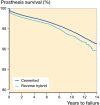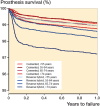Reverse hybrid total hip arthroplasty
- PMID: 28095724
- PMCID: PMC5434590
- DOI: 10.1080/17453674.2016.1278345
Reverse hybrid total hip arthroplasty
Abstract
Background and purpose - The use of a cemented cup together with an uncemented stem in total hip arthroplasty (THA) has become popular in Norway and Sweden during the last decade. The results of this prosthetic concept, reverse hybrid THA, have been sparsely described. The Nordic Arthroplasty Register Association (NARA) has already published 2 papers describing results of reverse hybrid THAs in different age groups. Based on data collected over 2 additional years, we wanted to perform in depth analyses of not only the reverse hybrid concept but also of the different cup/stem combinations used. Patients and methods - From the NARA, we extracted data on reverse hybrid THAs from January 1, 2000 until December 31, 2013. 38,415 such hips were studied and compared with cemented THAs. The Kaplan-Meier method and Cox regression analyses were used to estimate the prosthesis survival and the relative risk of revision. The main endpoint was revision for any reason. We also performed specific analyses regarding the different reasons for revision and analyses regarding the cup/stem combinations used in more than 500 cases. Results - We found a higher rate of revision for reverse hybrids than for cemented THAs, with an adjusted relative risk of revision (RR) of 1.4 (95% CI: 1.3-1.5). At 10 years, the survival rate was 94% (CI: 94-95) for cemented THAs and 92% (95% CI: 92-93) for reverse hybrids. The results for the reverse hybrid THAs were inferior to those for cemented THAs in patients aged 55 years or more (RR =1.1, CI: 1.0-1.3; p < 0.05). We found a higher rate of early revision due to periprosthetic femoral fracture for reverse hybrids than for cemented THAs in patients aged 55 years or more (RR =3.1, CI: 2.2-4.5; p < 0.001). Interpretation - Reverse hybrid THAs had a slightly higher rate of revision than cemented THAs in patients aged 55 or more. The difference in survival was mainly caused by a higher incidence of early revision due to periprosthetic femoral fracture in the reversed hybrid THAs.
Figures




References
-
- Australian Orthopaedic Association National Joint Replacement Registry Annual Report 2013. https://aoanjrr.sahmri.com/annual-reports-2013 - PubMed
-
- Clement N D, Biant L C, Breusch S J.. Total hip arthroplasty: to cement or not to cement the acetabular socket? A critical review of the literature. Arch Orthop Trauma Surg 2011; 132(3): 411–27. - PubMed
-
- Fine J P, Gray R J.. A Proportional Hazards Model for the Subdistribution of a Competing Risk. Journal of the American Statistical Association. Taylor & Francis 1999; 94(446): 496–509.
MeSH terms
LinkOut - more resources
Full Text Sources
Other Literature Sources
Medical
